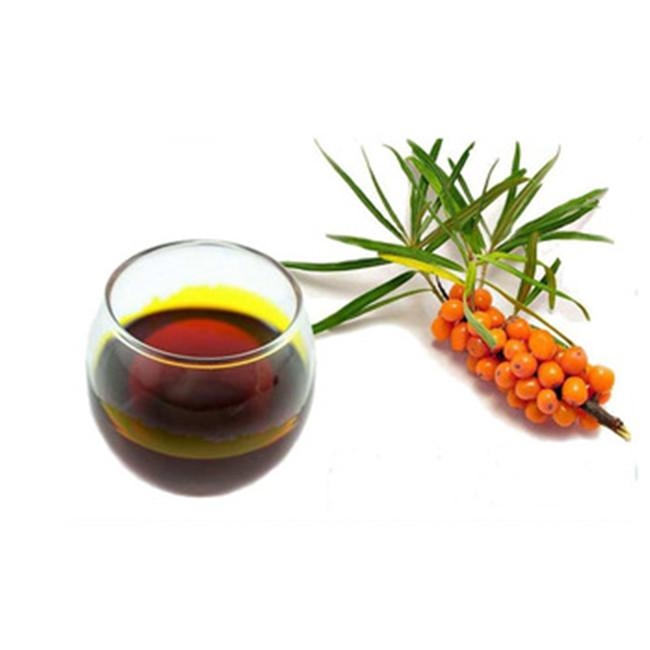
沙棘果油
品名: 沙棘果油
拉丁名: Hippophae Rhamnoides
有效成分 : 脂肪酸,VE,胡萝卜素
提取来源: 沙棘果
提取类型: 超临界提取
形式: 液体油

沙棘果油是以沙棘全果为原料,经CO2超临界萃取的一种 营养植物精油,具有沙棘果实特有的芳香气味。沙棘果油含丰富的油酸和亚油酸,含量高达85%。
沙棘,又称醋柳、酸刺,是生长在我国华北、西北和东北地区的一种野生落叶灌木或小乔木,果实为椭圆形,橙黄色。
据测定,沙棘果中除含有蛋白质、脂肪、碳水化合外,还有人体必需的多种维生素和无机盐,其中维生素含量丰富。尤以维生素C含量高,几乎居一切果、蔬之冠。每百克沙糖果中含维生素C可高达800~850毫克,高可达2100毫克以上;含维生素E15~220毫克;维生素A原的含量则相当于豆油的20~30倍,故而有“维生素宝库”之称。
沙棘果 含脂肪约11%,大部分由不饱和脂肪酸所组成,极易被人体吸收用,并能降低血液中的胆固醇和甘油三酯,可有效地防治高血压和冠心病。
沙棘果油是以优质精选的沙棘果为原料经过榨汁、高速离心分离、板框压滤等工艺而制得的棕红色澄清透明的油状液体,具有沙棘果实特有的芳香气味。沙棘果油富含100多种生物活性成分,在临床医学观察中具备了综合的多方面疗效功能。具有降血脂,抗溃疡、提高免疫力、美容等功效。
沙棘果油在消炎,抗溃疡方面作用亦较显著,适用于多种原因引起的胃炎、胃溃疡患者,其作用机理为沙棘果油在受损的粘膜处形成一层有效的保护膜,抵抗外界攻击因子,如胃酸及细菌等。而沙棘果油中的不饱和脂肪酸及VE类物质又为粘膜的修复提供营养,进而促进局部病变的修复。
我国民间有用沙棘来治疗消化系统疾病,包括胃、十二指肠溃疡、胃炎、消化不良等病。研究发现,沙棘油对胃溃疡有良好的促进愈合作用。
以上资料由上禾整理发布,仅供参考!产品详询13657416805

参考文献:
- 1.
Dale MM, Foreman JC, Fan TD: Textbook of Immunopharmacology, 3rd edn. Blackwell Scientific Publication, London
- 2.
Patwardhan B, Kalbag D, Patki PS, Nagsampagi BA: Search of immunomodulatory agents – a review. Indian Drugs 28: 249–254, 1991
- 3.
Charak Samhita. Translator: Shree Gulabkunverba Ayurvedic Society, Jamnagar, India, 1949
- 4.
Burger AM, Mengs U, Schuler JB, Fiebig HH: Anticancer activity of an aqueous mistletoe extract (AME) in syngeneic murine tumor models. Anticancer Res 21: 1965–1968, 2001
- 5.
Gracious ross R, Selvasubramanian S, Jayasundar S: Immunomodulatory activity of Punica granatum in rabbits – a preliminary study. J Ethnopharmacol 78: 85–87, 2001
- 6.
Zhao W, Ye Q, Tan X, Jiang H, Li X, Chen K, Kinghorn AD: Three new sesquiterpene glycosides from Dendrobium nobile with immunomodulatory activity. J Nat Prod 64: 1196–2000, 2001
- 7.
Kubena KS, Mcmurray DN: Nutrition and the immune system: A review of the nutrient-nutrient interactions. J Am Diet Assoc 96: 1156–1164, 1996
- 8.
Bagchi D, Bagchi M, Stohs SJ: Chromium (VI) induced oxidative stress, apoptotic cell death and modulation of p53 tumor suppressor gene. Mol Cell Biochem 222: 149–158, 2002
- 9.
Shrivastava R, Upreti R, Seth P, Chaturvedi U: Effects of chromium on the immune system. FEMS Immunol Med Microbiol 34: 1–7, 2002
- 10.
Tanigawa T, Araki T, Minato N: Decrease in Leu-11a negative lymphocytes in relation to natural killer cell activity in chromate workers. Br J Internal Med 48: 211–213, 1991
- 11.
Cohen MD, Zeikoff JT, Chen LC, Schlesinger RB: Immunotoxicologic effect of inhaled chromium: Role of particle solubility and coexposure to ozone. Toxicol Appl Pharmacol 152: 30–40, 1998
- 12.
Rousi A: The genus Hippophae L., A taxonomic study. Ann Bot Fenn 8: 177–227, 1971
- 13.
Eccleston C, Baoru Y, Tahvonen R, Kallio H, Rimbach GH, Minihane AM: Effects of an antioxidant rich juice (Seabuckthorn) on risk factors for coronary heart disease in humans. J Nutr Biochem 13: 346–354, 2002
- 14.
Yang B, Kalimo KO, Tahvonen, RL, Mattila LM, Katjisto JK, Kallio HP: Effects of dietary supplementation with sea buckthorn (Hippophae rhamnoides) seed and pulp oils on atopic dermatitis. J Nutr Biochem 10: 622–630, 1999
- 15.
Suleyman H, Gumustekin K, Taysi S, Keles S, Oztasan N, Aksas O, Altinkaynak K, Timur H, Akcay F, Akar S, Dane S, Gul M: Beneficial effects of Hippophae rhamnoides L. on nicotine induced oxidative stress in rat blood compared with vitamin E. Biol Pharm Bull 25: 1133–1136, 2002
- 16.
Goel HC, Prasad J, Singh S, Sagar RK, Kumar IP, Sinha AK: Radioprotection by a herbal preparation of Hippophae rhamnoides, RH-3 against whole body lethal irradiation in mice. Phytomed 9: 15–25, 2002
- 17.
Fushion Z: Comparative research on the contents of seabuckthorn oil and its physical chemical properties, composition of fatty acids and biologically active substance in Northwestern China. Chinese oil and Fat (shanxi) 2: 25–30, 1987
- 18.
Chen Y, Jiang Z, Qin W: Chemistry composition and characteristics of Seabuckthorn fruit and its oil. Chem Ind Forest Products (in Chinese) 10: 163–175, 1999
- 19.
Yao Y, Tigerstedt P: Variation of vitamin C concentration between and within natural seabuckthorn (Hippophae rhamnoides L.) populations. Acta Agric Scand 42: 12–17, 1992
- 20.
Yang B, Kallio HP: Fatty acid composition of lipids in Seabuckthorn (Hippophae rhamnoides L.) berries of different origins. J Agric Food Chem 49: 1939–1947, 2001
- 21.
Geetha S, Sai Ram M, Singh V, Ilavazhagan G, Sawhney RC: Anti-oxidant and immunomodulatory properties of Seabuckthorn (Hippophae rhamnoides) an in vitro study. J Ethnopharmacol 79: 373–378, 2002
- 22.
Sugiyama M, Tsuzuki K, Ogura R: Effect of ascorbic acid on DNA damage, cytotoxicity, glutathione reductase and formation of paramagnetic chromium in Chinese Hamster V-79 cells treated with sodium chromate (VI). J Biol Chem 266: 3383–3386, 1991
- 23.
Sai Ram M, Sharma SK, Ilavazhagan G, Kumar D, Selvamurthy W: Immunomodulatory properties of NIM-76, a volatile fraction from neem oil. J Ethnopharmacol 55: 133–139, 1997
- 24.
Atal CK, Sharma ML, Kaul Khajuria A: Immunomodulatory agents of plant origin. Preliminary screening. J Ethnopharmacol 41: 185–192, 1986
- 25.
Meydani SN, Wu D, Santos MS, Hayek MG: Antioxidants and immune status in aged persons: Overview of present evidence. Am J Clin Nutr 62: 1462S–1476S, 1995
- 26.
Sugiyama M: Role of physiological antioxidants in chromium (VI)-induced cellular injury. Free Radic Biol Med 12: 397–407, 1992
- 27.
Shi X, Chiu A, Chen CT, Halliwell B, Castranova V, Vallyathan V: Reduction of chromium (VI) and its relationship to carcinogenesis. J Toxicol Environ Health B Crit Rev 2: 87–100, 1999
- 28.
Kumar IP, Namita S, Goel HC: Modulation of chromatin organization by RH-3, a preparation of Hippophae rhamnoides, a possible role in radioprotection. Mol Cell Biochem 238: 1–9, 2002
- 29.
Novruzov EN: Flavonoids of different forms of Seabuckthorn (Hippophae rhamnoides L.) growing in Azerbaijan. In: V Singh and PK Khosla (eds). Proceedings of International Workshop on Seabuckthorn, New Delhi, India, 2001, pp 140–146.